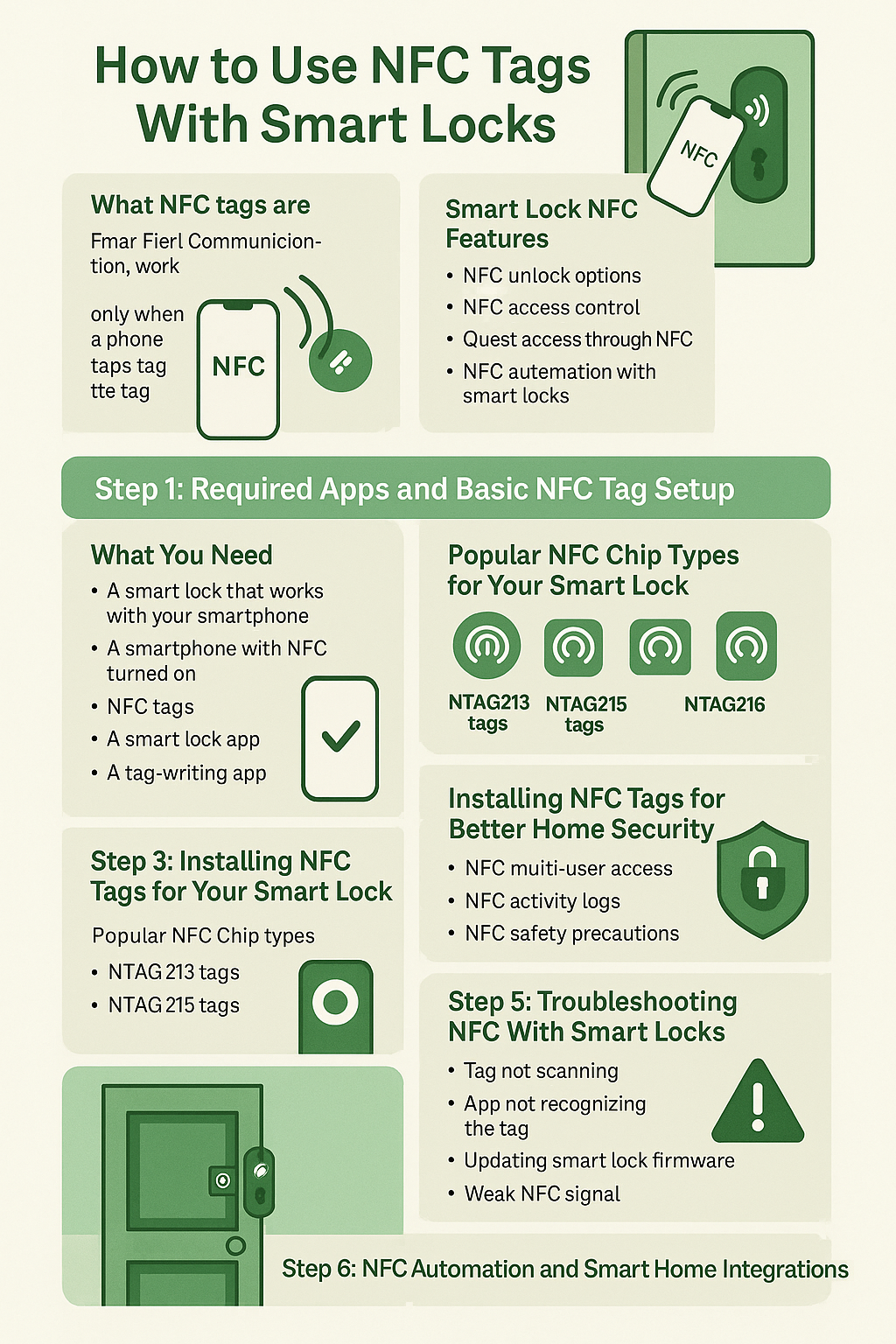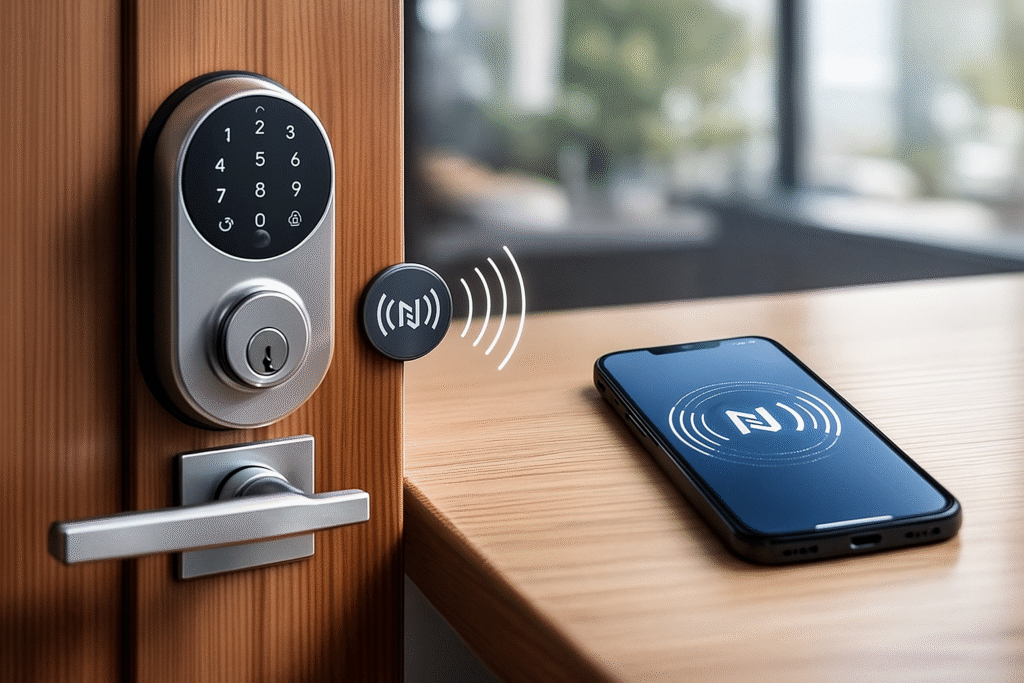Introduction: From “Where Are My Keys?” to “Tap and Go”
Imagine you’re coming home with grocery bags in both hands, maybe it’s dark, maybe you’re tired, and you just cannot be bothered to dig through your bag for keys. Instead, you simply tap your phone or a small NFC tag near the door, and click, your smart lock opens.
That’s the magic of using NFC tags with smart locks.
In this guide, we’ll break everything down in super simple language. You’ll learn:
- What NFC tags are
- How NFC tag setup for smart locks works
- Which types of NFC tags are compatible
- How to install and place them
- How to use NFC for home security and guests
- How to fix common problems
- Fun automations with Google Home, Apple Shortcuts, and Alexa
By the end, you’ll feel confident enough to say, “Yep, I can set this up myself.”

What Is an NFC Tag and How Does It Work With Smart Locks?
Think of an NFC tag as a tiny digital “note” that your phone can read.
- NFC stands for Near Field Communication.
- It works only when your phone or device is very close to the tag, usually just a few centimeters.
- When your phone “taps” the tag, it follows the instructions saved on it.
Smart Lock NFC Features
When you connect NFC with a smart lock, you can set things like:
- NFC unlock options
For example, tap your phone on a tag and your smart lock app opens ready to unlock. - NFC access control
You decide who can use which tag. Parents, kids, roommates, or trusted guests. - Guest access through NFC
You can create a tag that works only for certain days or hours, perfect for cleaners, babysitters, or Airbnb guests. - NFC automation with smart locks
Tap a tag and not only unlock the door, but also turn on lights, adjust temperature, or start a “Welcome Home” scene.
It’s like giving your home a little brain.
Step 1: Required Apps and Basic NFC Tag Setup
Before you start programming NFC tags, you’ll need a few things.
What You Need
- A smart lock that works with your smartphone
- A smartphone with NFC turned on (most modern phones have it in settings)
- NFC tags (we’ll talk about types in a moment)
- A smart lock app (like the app that came with your lock)
- A tag-writing app for NFC setup (search “NFC tools” or “NFC writer” in your app store)
Programming NFC Tags: Simple Example
Here’s a basic way people use NFC tag setup for smart locks:
- Open your smart lock app and find the shortcut or “quick action” that unlocks or opens the lock screen.
- Open your NFC tag writing app.
- Choose an action like “Open app” or “Run shortcut”.
- Select your smart lock app or a pre-made shortcut that unlocks the door.
- Hold your phone near the NFC tag when the app tells you to write.
- Done. Now when you tap your phone to that tag, it follows that command.
NFC Tag Compatibility and Security Settings
- Check your smart lock brand’s website or manual to confirm NFC compatibility.
- Make sure you turn on any NFC tag security settings in your smart lock app or phone. For example, requiring your fingerprint or face unlock before actually opening the door adds an extra safety layer.
You want it easy, but still safe.
Step 2: Choosing the Right Types of NFC Tags for Smart Locks
Not all NFC tags are the same. Some have more memory. Some are better for outdoor use. Here are common types:
Popular NFC Chip Types
- NTAG213 tags
Good for most basic smart home tasks. Often enough memory for simple lock actions. - NTAG215 tags
Slightly more memory and flexibility. Nice if you want to store more data or extra actions. - NTAG216 tags
Highest memory among these three. Useful if you plan to use the tag for more complex automations or extra info.
For smart lock NFC features, NTAG213 or NTAG215 is usually enough, but NTAG216 gives you more room to grow.
Tag Formats and Styles
You can pick tags based on where and how you’ll use them:
- Adhesive NFC tags (stickers)
Perfect for sticking near the door frame, behind a plant, or on a wall. - Keychain NFC tags
Great if you want something you can carry on your keys or bag. - Card-style NFC tags
Handy if you want something you can slide into a wallet or give to a guest like a hotel key card.
Choose what feels natural for your home and your family.
Step 3: Installing NFC Tags for Your Smart Lock
Now let’s talk about where and how to place your tags.
Tag Placement Tips
You want your tags to be:
- Easy to tap
- Not too obvious to strangers
- Safe from weather and damage
Indoor Placement
- Inside the hallway near the door
- Behind a small decoration, like a frame or shelf
- On a side table next to the entrance
This way, you tap after you enter or right before you leave. It’s safer because strangers on the street can’t see or reach the tag.
Outdoor Placement
If you really want an outside NFC tag:
- Hide it slightly, like under a mailbox flap or behind a doorbell frame.
- Avoid placing it where rain, sun, or snow will directly hit it.
- Make sure your phone can still reach it easily.
Mounting Methods
You can use different mounting methods depending on the type:
- Stickers
Peel and stick. Simple and clean. Just make sure the surface is dry and flat. - Key fobs
Attach to keys, bags, or lanyards. Tap when you reach the door. - Cards
Keep in your wallet or give to guests. Tap the card to the tag spot or reader area if your setup supports it.
If a spot feels annoying to reach when your hands are full, it’s not the right place. Test a few positions until it feels natural.
Step 4: Using NFC Tags for Better Home Security
NFC tags are not just for convenience. They can help with security too, if used wisely.
NFC Multi-User Access
You can create different tags or shortcuts for different users:
- Parents: Full access at all times
- Kids: Access only during certain hours (if your system supports schedules)
- Guests: Temporary NFC access; delete it when they’re done
This is NFC multi-user access in action.
NFC Activity Logs
Many smart locks keep activity logs. That means you can see:
- Who unlocked the door
- At what time
- Through which method (app, code, NFC, etc.)
This is helpful for parents, landlords, or anyone managing an Airbnb or rental property.
NFC Safety Precautions
A few simple rules:
- Do not place tags where any random person can easily tap them.
- Enable phone security, like fingerprint or face unlock, before the NFC action actually unlocks the door.
- If a tag gets lost or you think someone copied it, reset or delete that NFC action and create a new one.
Think of NFC tags like digital keys. Treat them with the same care.
Step 5: Troubleshooting NFC With Smart Locks
Things don’t always work perfectly. Here are common problems and what you can try.
Tag Not Scanning
If the tag is not scanning:
- Make sure NFC is turned on in your phone settings.
- Move your phone slowly over the tag until it finds the right spot. Different phones read from slightly different areas.
- Check if the tag is damaged, bent, or scratched.
App Not Recognizing the Tag
If your app doesn’t recognize the tag:
- Open your NFC tag app and see if the tag has any data written.
- Try resetting NFC tags by clearing or rewriting them with a new action.
- Make sure you’re using NFC tags that are compatible with your phone and app.
Updating Smart Lock Firmware
Sometimes the problem is not the tag, but the lock:
- Open your smart lock app
- Check for firmware updates
- Install any available updates
Updating smart lock firmware can fix bugs, improve NFC features, and make things run smoother.
Weak NFC Signal
If the NFC signal feels weak:
- Avoid placing tags on thick metal surfaces, which can block the signal.
- Try a different tag type or location.
- Test with another phone to see if the issue is with the device.
A bit of trial and error usually solves it.
Step 6: NFC Automation and Smart Home Integrations
This is where things get really fun. NFC tags don’t just open doors. They can trigger full smart home scenes.
NFC With Google Home
You can set up NFC tags to:
- Unlock your smart lock
- Turn on hallway or porch lights
- Play music or a welcome message
- Adjust your smart thermostat
With Google Home automations, one tap can start an entire “I’m home” routine.
NFC With Apple Shortcuts
Apple Shortcuts plus NFC is a powerful combo:
- You create a Shortcut that unlocks your smart lock, logs the time, and turns on lights.
- You tie that Shortcut to an NFC tag.
- Tap your iPhone to the tag, and the Shortcut runs automatically.
This makes NFC automation with smart locks feel like you’re living inside a smart movie.
NFC With Alexa Routines
If you’re using Alexa-compatible locks:
- Use your phone’s NFC tag app to trigger an Alexa Routine
- That routine can unlock the door, turn on lights, and even say “Welcome home” through your Echo
NFC Smart Home Scenes
Here are a few scene ideas:
- Good Morning Tag inside your bedroom
- Unlocks door (optional)
- Turns on lights
- Starts coffee machine (if smart)
- Unlocks door (optional)
- Goodnight Tag near your bed
- Locks all doors
- Turns off lights
- Arms your security system
- Locks all doors
- Guest Tag at a rental or guest room
- Unlocks front door
- Sends you a notification when used
- Unlocks front door
With a bit of creativity, NFC smart home scenes can make daily life smoother and safer.

Conclusion: Tap Your Way to a Smarter Front Door
Using NFC tags with smart locks is like upgrading from an old rusty key to a tiny magic button. With a simple tap, you can:
- Unlock your door
- Control who gets in and when
- Keep an eye on activity logs
- Run smart home scenes that fit your lifestyle
You don’t need to be a tech expert. Just:
- Pick compatible NFC tags (like NTAG213, NTAG215, or NTAG216)
- Use the right apps for NFC setup
- Place tags in smart, safe spots
- Set up security steps like phone biometrics
- Play with automations using Google Home, Apple Shortcuts, or Alexa Routines
Little changes like these can make your home feel more modern, secure, and honestly, a lot more fun.
